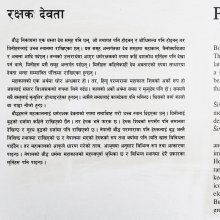Dark blue: 2 definitions
Introduction:
Dark blue means something in Hinduism, Sanskrit. If you want to know the exact meaning, history, etymology or English translation of this term then check out the descriptions on this page. Add your comment or reference to a book if you want to contribute to this summary article.
Images (photo gallery)
In Hinduism
Natyashastra (theatrics and dramaturgy)
Source: Shodhganga: Elements of Art and Architecture in the Trtiyakhanda of the Visnudharmottarapurana (natya)The Dark-blue (colour) is denoted by the Sanskrit word Śyāma and is associated with Śṛṅgāra or the “erotic sentiment”, which represents one of the nine kinds of Rasa (“soul of Drama”), according to the Viṣṇudharmottarapurāṇa, an ancient Sanskrit text which (being encyclopedic in nature) deals with a variety of cultural topics such as arts, architecture, music, grammar and astronomy.—Śṛṇgāra-rasa is the sentiment of love and desire where the manifestation of the activities of Kāmadeva i.e the god of love can be noticed. Rati i.e erotic emotion is the sthāyībhāva or permanent feeling of śṛṇgāra. Śyāma i.e dark blue is the colour of this sentiment. Viṣṇu is the God of this sentiment.

Natyashastra (नाट्यशास्त्र, nāṭyaśāstra) refers to both the ancient Indian tradition (shastra) of performing arts, (natya—theatrics, drama, dance, music), as well as the name of a Sanskrit work dealing with these subjects. It also teaches the rules for composing Dramatic plays (nataka), construction and performance of Theater, and Poetic works (kavya).
Shilpashastra (iconography)
Source: Shodhganga: Elements of Art and Architecture in the Trtiyakhanda of the Visnudharmottarapurana (shilpa)Dark blue (colour) is denoted by the Sanskrit term Nīla and represents one of the five primary colours in the ancient Indian tradition of Painting (citra), according to the Viṣṇudharmottarapurāṇa, an ancient Sanskrit text which (being encyclopedic in nature) deals with a variety of cultural topics such as arts, architecture, music, grammar and astronomy. In the Viṣṇudharmottarapurāṇa, five colours are regarded as the primary ones, e.g., Dark blue (nīla). Mixing of colours is a great technique used by the artists to make numerous shades of colours. A painter can create hundreds or thousands of colours by amalgamating the primary ones.

Shilpashastra (शिल्पशास्त्र, śilpaśāstra) represents the ancient Indian science (shastra) of creative arts (shilpa) such as sculpture, iconography and painting. Closely related to Vastushastra (architecture), they often share the same literature.
See also (Relevant definitions)
Full-text (+648): Mecaka, Shyama, Nila, Shyamala, Nilambara, Nilavasas, Kalanga, Krishna, Nailya, Nilavasana, Siti, Nilavarna, Krishnavarna, Mahanila, Nilalohita, Kannila, Atinila, Kagu, Manuka, Mecakita.
Relevant text
Search found 90 books and stories containing Dark blue; (plurals include: Dark blues). You can also click to the full overview containing English textual excerpts. Below are direct links for the most relevant articles:
The Great Chronicle of Buddhas (by Ven. Mingun Sayadaw)
Part 23 - Eight Ways of Mastery of the Mind through Concentration < [Chapter 40 - The Buddha Declared the Seven Factors of Non-Decline for Rulers]
Part 15 - The Buddha’s Sojourn at The Mango Grove of Ambapālī at Vesālī < [Chapter 40 - The Buddha Declared the Seven Factors of Non-Decline for Rulers]
Discourse on Laṭukika Jātaka < [Chapter 22 - Founding of Vesali]
Sahitya-kaumudi by Baladeva Vidyabhushana (by Gaurapada Dāsa)
Text 7.60 < [Chapter 7 - Literary Faults]
Text 7.19 < [Chapter 7 - Literary Faults]
Text 7.54 < [Chapter 7 - Literary Faults]
Rig Veda (translation and commentary) (by H. H. Wilson)
Rig Veda 5.43.12 < [Sukta 43]
Cosmetics, Costumes and Ornaments in Ancient India (by Remadevi. O.)
6. Make -up for Stage Performance < [Chapter 1 - Cosmetics]
1.2. Materials (e): Indranīla (Sapphire) < [Chapter 3 - Ornaments]
2.18. Dressing on the Basis of Profession < [Chapter 2 - Costumes]
Tiruvaymoli (Thiruvaimozhi): English translation (by S. Satyamurthi Ayyangar)
Pasuram 7.7.9 < [Section 7 - Seventh Tiruvaymoli (Elaiyar avo)]
Pasuram 5.5.8 < [Section 5 - Fifth Tiruvaymoli (Ennaneyo, annaimirkal)]
Pasuram 3.8.8 < [Section 8 - Eighth Tiruvaymoli (Mutiyane)]
The Great Chariot (by Longchenpa)
Part 4a.3 - Meditating on the deities < [B. The explanation of meditation practice, together with its action of ripening and freeing]
Part 4a.4 - The great mandala of the environment and inhabitants < [B. The explanation of meditation practice]
Part 3d.2a - The perfect place < [B. The explanation of the kayas and wisdoms]
